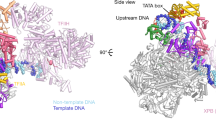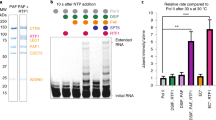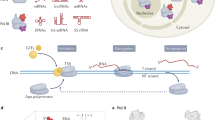Abstract
AT least six chromatographically resolvable general transcription factors may participate in accurate initiation by RNA polymerase II in HeLa cell-derived systems1–3. TFIIF (also termed FC, RAP30/74 and β/γ) can bind directly to RNA polymerase II in solution4–6 and decrease the affinity of RNA polymerase II for nonspecific DNA7. From studies on the kinetics of transcription initiation1, on the composition of transcription initiation complexes fractionated by acrylamide gel electrophoresis8, and on template competition experiments9, TFIIF is known to act at an intermediate stage in initiation complex formation. It acts after TFIID firmly associates with DNA, but coincidentally with or immediately after RNA polymerase II binding to DNA, and before the recruitment of factor TFIIE. TFIIF may6 or may not4,5 have DNA helicase activity. The small subunit (RAP30) of TFIIF has been cloned6 and shows some amino-acid sequence homology to bacterial cr factors. We have partially sequenced the RAP74 protein from purified HeLa cells, cloned its complementary DNA and shown that its translation product can interact with RAP30 in vitro as well as in vivo. The cDNA predicts an amino-acid sequence that lacks obvious DNA or RNA helicase motifs. It has regions rich in charged amino acids, including segments containing a higher content of acidic amino acids than are found in strong transcriptional activators such as VP16 (ref. 10).
This is a preview of subscription content, access via your institution
Access options
Subscribe to this journal
Receive 51 print issues and online access
$199.00 per year
only $3.90 per issue
Buy this article
- Purchase on SpringerLink
- Instant access to full article PDF
Prices may be subject to local taxes which are calculated during checkout
Similar content being viewed by others
References
Kitajima, S., Kawaguchi, T., Yasukochi, Y. & Weissman, S. M. Proc. natn. Acad. Sci. U.S.A. 86, 6106–6110 (1989).
Inostroza, J., Flores, O. & Reinberg, D. J. biol. Chem. 266, 9304–9308 (1991).
Sumimoto, H., Ohkuma, Y., Yamamoto, T., Horikoshi, M. & Roeder, R. G. Proc. natn. Acad. Sci. U.S.A. 87, 9158–9162 (1990).
Flores, O., Ha, I. & Reinberg, D. J. biol. Chem. 265, 5629–5634 (1990).
Kitajima, S. et al. Nucleic Acids Res. 18, 4843–4849 (1990).
Sopta, M., Burton, Z. F. &, Greenblatt, J. Nature 341, 410–414 (1989).
Conaway, J. W. & Conaway, R. C. Science 248, 1550–1553 (1990).
Burtowski, S., Hahn, S., Guarente, L. & Sharp, P. A. Cell 56, 549–561 (1989).
Conaway, R. C. & Conaway, J. W. J. biol. Chem. 265, 7559–7563 (1990).
Triezenberg, S. J., Kingsbury, R. C. & McKnight, S. L. Genes Dev. 2, 718–729 (1988).
Studier, F. W., Rosenberg, A. H., Dunn, J. J. & Dubendoroff, J. W. Meth. Enzym. 185, 60–89 (1990).
Möller, W. & Amons, R. FEBS Lett. 186, 1–7 (1985).
Sadowski, I. & Ptashne, M. Nucleic Acids Res. 17, 7539 (1989).
Vasavada, H., Ganguly, S., Germino, F. J., Wang, Z. X. & Weissman, S. M. Proc. natn. Acad. Sci. U.S.A. (in the press).
Lathe, R. J. molec. Biol. 183, 1–12 (1985).
Swaroop, A. & Weissman, S. M. Nucleic Acids Res. 16, 8739 (1988).
Sadowski, I., Ma, J., Triezenberg, S. J. & Ptashne, M. Nature 335, 563–564 (1988).
Horikoshi, M., Fujita, H., Wang, J., Takada, R. & Roeder, R. G. Nucleic Acids Res. 19, 5436 (1991).
Ganguly, S., Vasavada, H. & Weissman, S. M. Proc. natn. Acad. Sci. U.S.A. 86, 5247–5251 (1989).
Author information
Authors and Affiliations
Rights and permissions
About this article
Cite this article
Aso, T., Vasavada, H., Kawaguchi, T. et al. Characterization of cDNA for the large subunit of the transcription initiation factor TFIIF. Nature 355, 461–464 (1992). https://doi.org/10.1038/355461a0
Received:
Accepted:
Issue Date:
DOI: https://doi.org/10.1038/355461a0
This article is cited by
-
Reconstitution of chromatin transcription with purified components reveals a chromatin-specific repressive activity of p300
Nature Structural & Molecular Biology (2006)
-
Identification of differentially expressed genes HSPC016 in dermal papilla cells with aggregative behavior
Archives of Dermatological Research (2005)
-
Interaction with RAP74 subunit of TFIIF is required for transcriptional activation by serum response factor
Nature (1995)



